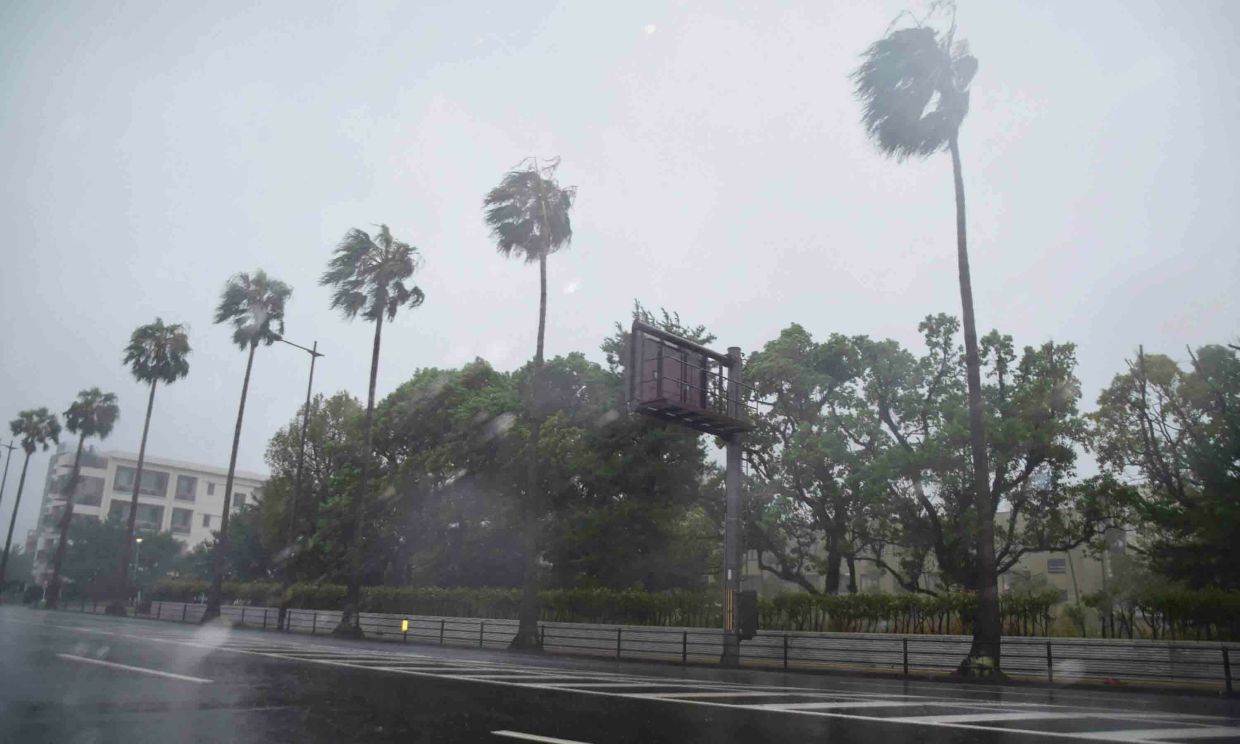
Thousands shelter in place as 'dangerous' typhoon hits Japan; government issues tsunami warning after Taiwan earthquake
MINAMATA, Japan, Sept 18, 2022 (AFP): Thousands of people took refuge in shelters in southwestern Japan on Sunday as powerful Typhoon Nanmadol churned towards the region, prompting authorities to urge over four million residents to evacuate.
The Japan Meteorological Agency (JMA) has issued a rare “special warning” for Kagoshima and Miyazaki in the Kyushu region — an alert that is issued only when it forecasts conditions seen once in several decades.
By Sunday morning, heavy rain and high winds lashed the area on Japan’s southern island, with nearly 98,000 households in Kagoshima, Kumamoto, Nagasaki, and Miyazaki already without power.
Trains, flights, and ferry runs were canceled until the passage of the storm, and even some convenience stores — generally open all hours and considered a lifeline in disasters — were shutting their doors.
“Please stay away from dangerous places, and please evacuate if you feel even the slightest hint of danger,” Prime Minister Fumio Kishida tweeted after convening a government meeting on the storm.
“It will be dangerous to evacuate at night. Please move to safety while it’s still light outside,” he added.
The JMA has warned the region could face “unprecedented” danger from high winds, storm surges, and torrential rain.
“Maximum caution is required,” Ryuta Kurora, head of the JMA’s forecast unit said on Saturday.
“It’s a very dangerous typhoon.”
“The wind will be so fierce that some houses might collapse,” Kurora told reporters, also warning of flooding and landslides.
National broadcaster NHK, which collates local warnings, said more than four million people across Kyushu were issued evacuation warnings, with officials in Kagoshima and Miyazaki saying over 15,000 people were in local shelters by Sunday afternoon.
The evacuation warnings call on people to move to shelters or alternative accommodations that can withstand extreme weather.
But they are not mandatory, and during past extreme weather events authorities have struggled to convince residents to take shelter quickly enough.
Kurora urged people to move before the worst of the storm arrived and warned that even in sturdy buildings residents would need to take precautions.
“Please move into sturdy buildings before violent winds start to blow and stay away from windows even inside sturdy buildings,” he told a late-night press conference.
– ‘Highest caution possible’ –
By Sunday morning, bullet train operations in the area were halted, and NHK said hundreds of flights had been canceled.
“The southern part of the Kyushu region may see the sort of violent wind, high waves, and high tides that have never been experienced before,” the JMA said Sunday, urging residents to exercise “the highest caution possible”.
On the ground, an official in Kagoshima’s Izumi city said conditions were deteriorating rapidly.
“The wind has become extremely strong. Rain is falling hard too,” he told AFP. “It’s a total white-out outside. Visibility is almost zero.”
On the coast in Kyushu’s Minamata city, fishing boats tied up for safety bobbed on the waves, as spray from the sea and bands of rain sluiced the boardwalk.
As of 1 pm (0400 GMT), the typhoon was located above tiny Yakushima island, packing gusts up to 234 kilometers (146 miles) per hour.
It is expected to make landfall in Kyushu on Sunday evening, before turning northeast and sweeping up across Japan’s main island through early Wednesday.
Japan is currently in typhoon season and faces around 20 such storms a year, routinely seeing heavy rains that cause landslides or flash floods.
In 2019, Typhoon Hagibis smashed into Japan as it hosted the Rugby World Cup, claiming the lives of more than 100 people.
A year earlier, Typhoon Jebi shut down Kansai Airport in Osaka, killing 14 people.
And in 2018, floods and landslides killed more than 200 people in western Japan during the country’s annual rainy season.
Scientists say climate change is increasing the severity of storms and causing extreme weather such as heat waves, droughts, and flash floods to become more frequent and intense.
– Strong quake strikes eastern Taiwan, Japan issues tsunami alert –
A strong earthquake struck Taiwan’s southeastern coast on Sunday, the US Geological Survey said, bringing at least one building down in a small town and prompting Japan to issue a tsunami warning.
The quake hit at 2:44 pm (0644 GMT) about 50 kilometers (30 miles) north of the city of Taitung at a depth of 10 kilometers, the USGS said.
Its initial strength was given as 7.2-magnitude but USGS later downgraded it to a 6.9-magnitude quake.
At least one building collapsed in the town of Yuli according to Taiwan’s semi-official Central News Agency.
A video posted by CNA showed panicked residents running towards the building which had caved in on itself and sent up a thick cloud of dust.
Shaking was also felt in the capital Taipei, an AFP reporter said.
A 6.6 magnitude quake hit the same region on Saturday and there have been multiple tremors since with minimal damage in what is a mountainous, sparsely populated rural region.
But Sunday’s quake was much stronger.
Japan’s Meteorological Agency issued a tsunami advisory to remote islands near Taiwan.
Waves as high as one meter were expected to arrive around 4 pm (0700 GMT), it added.
Live TV footage from the affected islands did not immediately show clear signs of high waves.
The China Earthquake Network Centre said tremors were felt in coastal areas including Fujian, Guangdong, Jiangsu, and Shanghai.
Taiwan is regularly hit by earthquakes as the island lies near the junction of two tectonic plates.
The island sits on the Pacific “Ring of Fire”, an arc of intense seismic activity that stretches through Southeast Asia and across the Pacific basin.
Taiwan’s deadliest ever quake was a 7.6-magnitude jolt in September 1999 that killed over 2,400 people.
